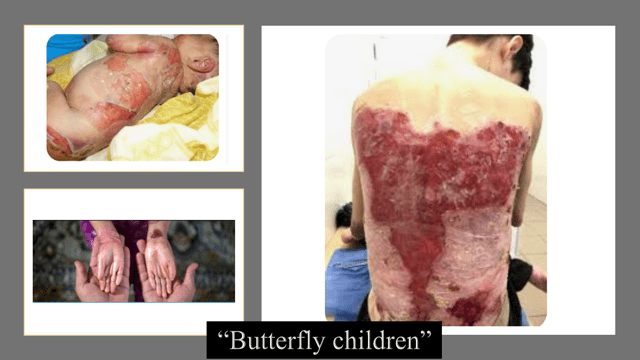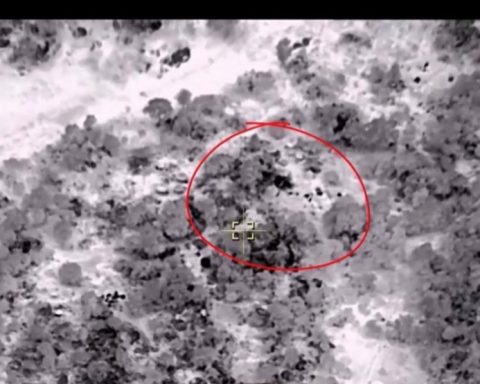Recessive Dystrophic Epidermolysis Bullosa (RDEB), is a lifelong incurable skin condition. It is associated with skin blistering, wounding and scarring; and is quite often fatal. The condition is caused by a lack of collagen protein in the skin.
The RDEB is one of many genetic skin conditions under the generic name of Epidermolysis Bullosa (EB). Epidermolysis bullosa in one form or the other occurs in about 1 in every 50,000 live births. The disorder is interracial and interethnic throughout the world, and affects both genders in equal measure.
Collagen is an essential component of the skin, required for skin elasticity, moistening and toughening. As the body ages, so is its ability to secrete collagen progressively decline. This causes dry skin and wrinkles. The absence of collagen makes the skin to become very fragile so that the slightest friction blisters the skin. Those born with this rare genetic condition are often called “butterfly children”, a reference to the delicate nature of butterfly wings.
Join our WhatsApp ChannelThis absence of vital skin collagen is due to mutations in a gene called COL7AI. This gene encodes for a protein called collagen VII (or C7), responsible for binding together the epidermis (outer skin layer) and dermis (middle skin layer).
READ ALSO: How Spinal Cord Stimulation Helps Paralytics Walk Again
When there is a defect in the collagen VII gene, the cohesion between the epidermis and dermis is lost, and the layers slide across each other. This results in blistering and fibrosis at birth, accompanied by scarring and open wounds. The condition often leads to high predisposition to wound infections and skin cancer. In some cases the oesophagus is swollen due to friction when swallowing solid food, so that the patient is reduced to taking only liquid food. Even to clean one’s self after toileting becomes a problem as rubbing toilet tissue against the skin leads to blisters and open wounds. And in certain cases, blisters form around the eyes, so that sufferers have to keep their eyes constantly closed. The disease is extremely painful and the condition of the sufferer deteriorates over time resulting in deaths in early adulthood.
No definitive cure for the condition has been found to date, but there are a number of replacement gene therapies being trialled ranging from bone marrow replacement, which is at times lethal, to skin grafts. These gene therapies are geared towards promoting collagen VII (or C7) expression and by so doing enable skin healing, but they are not surefire solutions to the condition. In the interim to finding a cure, supportive care includes daily wound care, bandaging, and pain management as required.
But what if there is a way to effect direct gene transfer of the normal COL7A1 genes into the skin of those suffering from RDEB so that they can start producing collagen properly? This type of research has been going on but has never achieved any measurable success until recently.
But let’s digress a bit and mention another disease: the human simplex virus type 1 (HSV-1), which causes sores around the mouth and lips (i.e. cold sores), and in some cases also causes genital herpes. In uncommon cases also, HSV-1 infection can lead to meningitis (inflammation of the covering of the brain and spinal cord) or encephalitis (inflammation of the brain).
You may wonder what the two aforementioned diseases have in common. The answer is nothing, until now. Marinkovich and coworkers writing in the 28 March 2022 issue of the journal, Nature Medicine, reported a new gene therapy for RDEB. They embedded the therapeutic gene (COL7AI) inside the cold virus (HSV-1) in gel format so that it is spread all over the body just like applying an ointment.
This experiment was done by using herpes simplex virus-1 as a vector to deliver two copies of the COL7A1 genes into skin cells. Don’t panic! The virus was modified in a way that it does not integrate and multiply in the human genome, and cause disease.
You may ask, why use HSV-1? The answer is that the genome of the virus is large enough to accommodate the collagen COL7A1 gene, which by itself, is quite big. And the second reason is that over the years, the virus has evolved in such a way that it does not raise any effective immunological response in humans. This is the main reason most herpes infections are persistent and near incurable.
The DNA-spiked gel was tested in a clinical trial involving 31 children and adults with recessive dystrophic epidermolysis bullosa (RDEB). Each person received an application of the gene-infused gel on one of their wounds, and a control gel (or placebo) on another of their wounds. The viral vector does not penetrate deeply into intact skin and the collagen gene is not stable and degrades over time as the treated skin cells slough off. Therefore, the gel was applied once every week for three months. At the end of the 3-month therapy session, 71% of the wounds treated with the gene therapy had healed completely compared with only 20% of the wounds treated with inactive gel.
In one instance, a large 10-year-old wound, which covered almost all the side of a patient’s body was up to 70% healed and other wounds were equally closed completely upon treatment with the DNA gel. In another case, a 5-year-old chronic wound completely closed after just two successive rounds of treatments. The wound remained closed throughout the 8-month monitoring period.
“The wounds heal quickly but, even more importantly, they stay closed,” an overjoyed Peter Marinkovich, said during a press briefing. “The therapy strengthens the skin and breaks the painful and destructive cycle of wound opening and closing that patients with epidermolysis bullosa experience.”
Biopsy results of the treated skin from some of the participants in the trial, showed that the skin was actively making collagen VII as early as 9 days after the initial application of the gel.
The attractiveness of the gene therapy is that it is safe, non invasive, and simple, with no adverse effects. The gel is topically applied directly to the surface of the wound, and due to its simplicity, the gel could be used off the shelf anywhere in the world. The gel is recommended to be applied at least twice a year, after the initial treatments. This is because as mentioned earlier, the newly introduced COL7A1 genes are not everlasting and eventually die off; therefore, new genes to take up the place of the old ones must be introduced by repeat application of the gel.
The researchers are planing to test the gel on other areas of the body associated with RDEB wounds, like the cornea, oesophagus, and the anus. The researchers in partnership with a biotech company called Krystal Biotech, plan to apply for approval from the US Food and Drug Administration (FDA). This will then pave the way to making the gel available to patients.














